The BMW i3 is a high-roof hatchback with an electric powertrain and optional gasoline engine. It was BMW’s first mass-produced zero-emissions vehicle (ZEV) and part of BMW’s i sub-brand of electric vehicles (EVs). The i3 debuted as a concept vehicle at the 2011 International Motor Show Germany. Units were first delivered to US markets in the spring of 2014 for the 2014 model year. BMW discontinued production of the i3 for the US after the 2021 model year.
BMW i3 Overview
The BMW i3 initially weighed about 2,700 pounds. 450 pounds of that came from the 22 kilowatt-hour (kWh) battery, although only 19 kWh of that capacity was actually available for use. BMW achieved this low weight with the extensive use of lightweight materials like aluminum, carbon fiber and magnesium. In addition, the i3 was the first mass-produced car to be composed mostly of carbon-fiber reinforced plastic (CFRP).
US versions of the i3 had three trim packages that primarily affected the wheels and interior. The Mega World was the base trim, which includes 19-inch Style 427 wheels and cloth seats. The Giga World trim cost an additional $1,700 and added a sunroof, 19-inch Style 429 wheels and leather accents. The Tera World trim cost $2,700 over the base trim and added Style 428 wheels, with a leather interior.
An optional two-cylinder engine known as the (REx) option was available for the i3 to extend its short range, adding 330 pounds to its weight. BMW also offered two other option packages for the i3, including Parking Assistant and Driving Assistant. The Parking Assistant package cost $1,000 and added a backup camera with parking assistance. The Driving Assistant package added $2,500 to the vehicle’s cost and added adaptive cruise control, wide-screen navigation and deceleration assistance. 20-inch Style 430 double-spoke wheels were also options for the Giga and Tera trims.
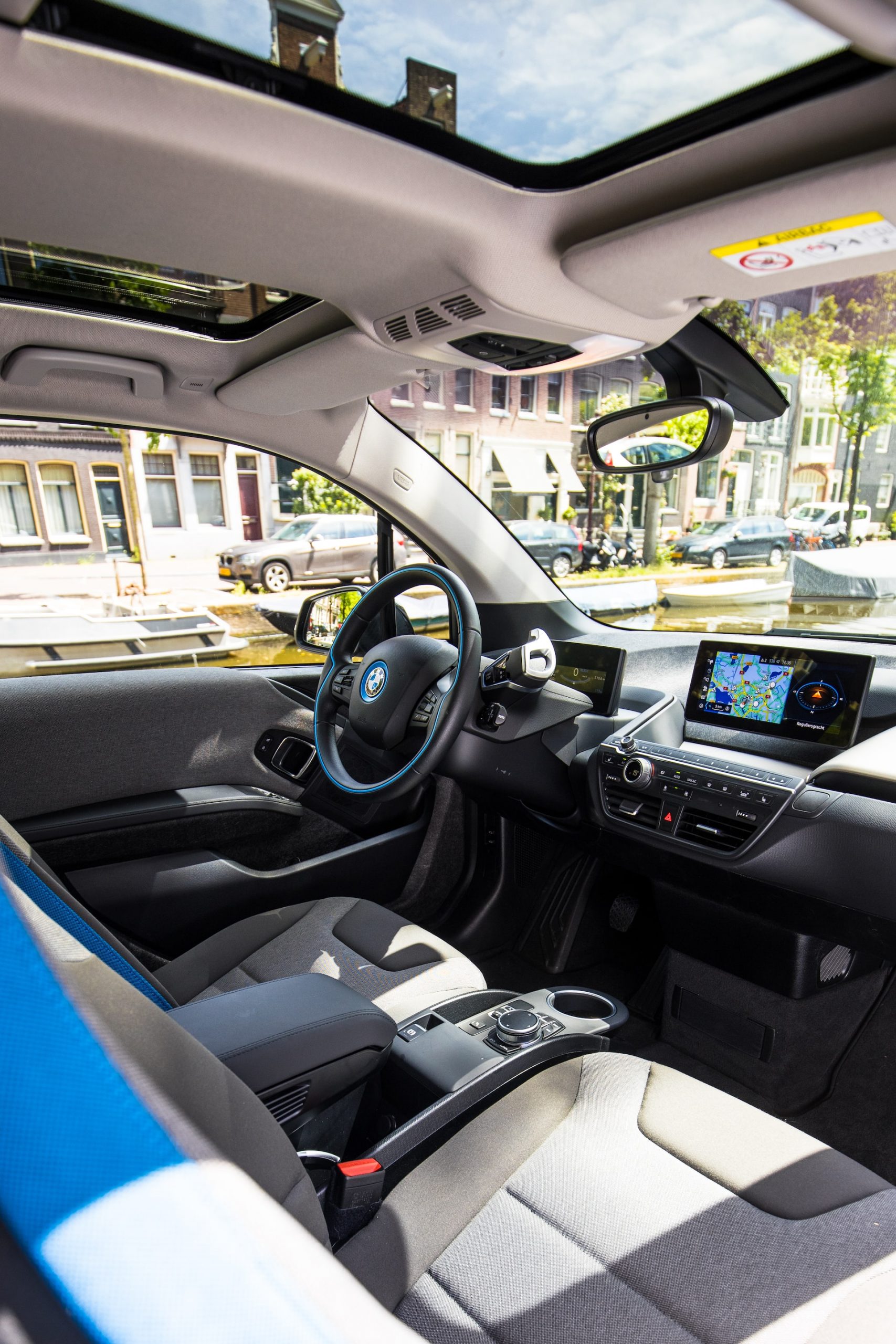
EVU Hot Take
Pros:
- Quick acceleration
- Nimble handling- great for a city car
- Eco-friendly materials
Cons:
- Short range on battery alone
- Lack of cargo space
- Interior
The driver receives information from two separate displays in the i3, including the 8.8-inch central information display and 6.5-inch freestanding instrument cluster. The interior floor lacks a tunnel down the middle of the cabin since the i3 doesn’t have a floor-mounted transmission. Instead, the front seats are based on benches that take advantage of the flat floor.
BMW i3 Models
Major changes to the i3 occurred in the 2017, 2018, and 2019 model years.
BMW i3 2017 Model Year
The first major changes for the i3 occurred in the 2017 model year. It received a much-needed upgrade for its battery, which now has a capacity of 33 kWh. BMW and Samsung achieved this improvement without increasing its size by increasing the electrolytes and changing the active materials in the internal cells. The battery’s electronics package was also upgraded to better control its cooling system and the motor. These changes increased the all-electric vehicle’s weight to 2,910 pounds.
The capacity of the fuel tank for the REx option was also effectively increased by 25 percent, although its physical dimensions didn’t change. BMW initially used software to lock out part of the tank in American markets to meet regulatory requirements for EVs with range-extending engines. In particular, the entire fuel tank gave the i3 a greater range from the engine than the battery. This prevented it from being classified as a ZEV in California.
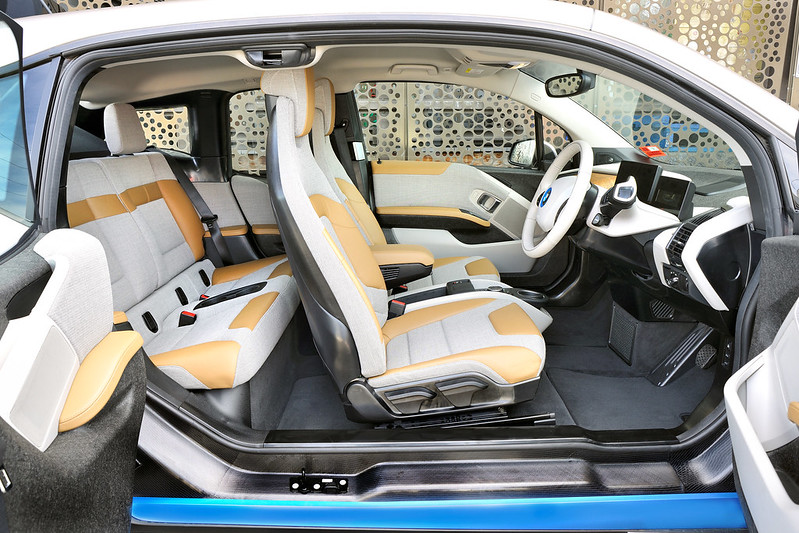
“BMW i3 – First Drive” by The National Roads and Motorists’ Association is licensed under CC BY 2.0.
BMW i3 2018 Model Year
The BMW i3’s exterior experienced a refresh in the 2018 model year, including new bumpers. Changes in the front included standard LED headlights and horizontal fog light openings. Rear changes included a horizontal silver bar on the rear hatch. Fender flares widened the i3’s profile and the roofline received a silver accent.
BMW also added the i3s in 2018, which was a sportier version of the i3. The BMW i3s offers a more powerful motor. Additional performance features include lower suspension, a SPORT driving mode and wider Style 431 double-spoke wheels exclusive to this model. Many of the i3’s chrome accents were also blacked out on the i3s. These changes added about 44 pounds to the i3’s weight.
BMW i3 2019 Model Year
A larger battery was the most significant change for the 2019 model year, which now has a capacity of 42.2 kWh. It added 55 pounds to the vehicle’s weight. This brings the total weight to 2,965 pounds for the i3 and 3,009 pounds for the i3s. Minor changes for the 2019 model year included adaptive headlights and more color options.
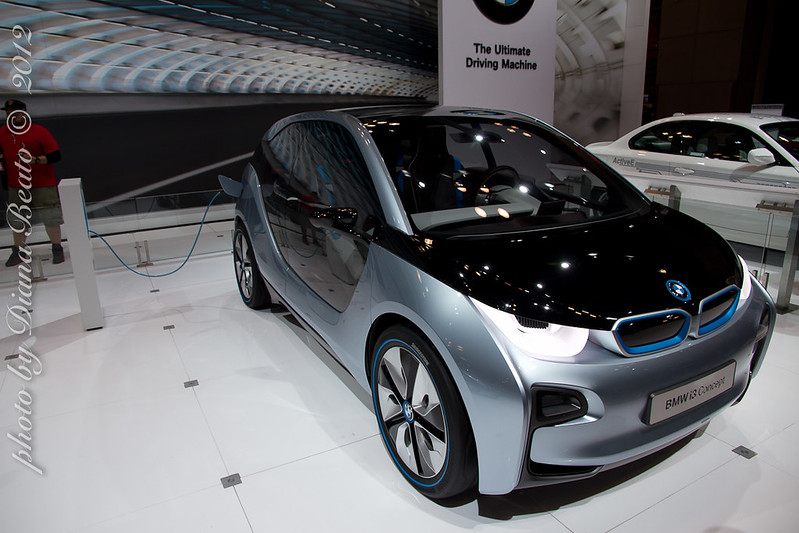
“BMW i3 Concept Electric Vehicle” by VideoPhotoholic is licensed under CC BY-SA 2.0.
BMW i3 Exterior
A clean-sheet design gave the BMW i3 a sporty appearance by taking advantage of the absence of an internal combustion engine under the hood. It seats four occupants and has four doors, with suicide doors in the rear. The passenger compartment is composed of CFRP and sits atop the drive module, which includes aluminum components such as the frame, powertrain, suspension and battery. The door panels are made of hemp and plastic, which reduces their weight by about ten percent.
In addition to weight reduction, BMW designed the i3 with an eye towards environmental considerations. For example, the optional leather upholstery is tanned with olive-leaf extract, rather than the synthetic chemicals that are typically used in tanning. In addition, the dashboard trim is made from eucalyptus trees certified as cultivated in a sustainable manner.
Bridgestone designed the i3’s tires to minimize aerodynamic drag and rolling resistance by using a greater diameter, narrower width and higher inflation pressure. The 155/70 tires have a diameter of 19 inches and an inflation pressure of 46 psi, as compared to 175/65 tires with a diameter of 15 inches and an inflation pressure of 30 psi that’s typical for a car in this class. Bridgestone supplied similar tires to World Solar Challenge teams, which require highly efficient tires.
BMW i3 Powertrain
The BMW I3 electric motor drives the rear axle and is located between the rear wheels, and there is a space to the right for the gasoline engine. The base model I3 generates 170 hp and 184 foot-pounds (lb⋅ft) of torque, while the i3s generates 181 hp and 199 lb⋅ft of torque. A governor limits the i3’s top speed to 93 mph.
BMW i3 Range
The battery for the 2014 to 2016 models is 22 kWh, 33 kWh for 2017 and 2018 models, and 42.2 kWh for 2019 and later models. The official range for the 22-kWh battery is 80 to 100 miles. That said, it goes up to 120 miles in the most efficient driving mode.
The Environmental Protection Agency (EPA) rates the i3’s smallest battery range at 81 miles, giving it a Miles Per Gallon equivalent (MPGe) of 124. The EPA range estimate for the 33-kWh battery is 114 miles for the i3 and 107 miles for the i3s. The estimated range for the 42.2-kWh battery is 153 miles for both trims. These figures assume the vehicle is not equipped with the optional gasoline engine.
These ratings make the all-electric i3 the most efficient vehicle sold in the US until 2016, according to the EPA. The Hyundai Ioniq surpassed the i3 in that year with a rating of 136 MPGe.
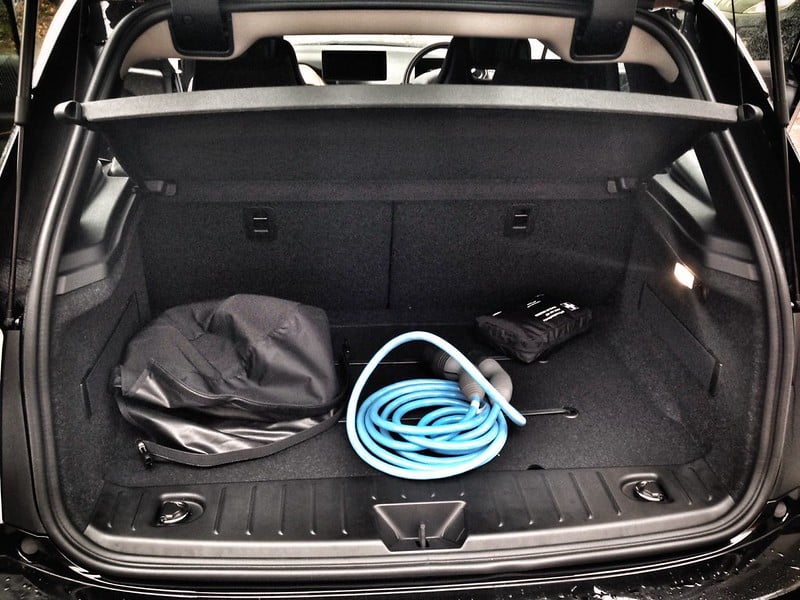
“BMW i3 Boot With Charging Cable Car Leasing Made Simple” by Carleasingmadesimpletm is licensed under CC BY 2.0.
BMW i3 Charging
The BMW i3 design assumes that the battery requires charging every two to three days, based on typical commuting use. The charging inlet for the i3 is a combined charging system (CCS) port located above the right rear wheel. In North America, this Combo 1 port accepts AC and DC electric supply equipment (EVSE).
The i3 offers multiple charging options. For example, you can use AC fast charging for a standard wall socket that charges the 22-kWh battery from 0 to 80 percent in less than three hours. It also accepts DC charging stations to obtain 50-kW DC fast charging, charging the battery to 80 percent capacity in less than 30 minutes. Larger batteries take proportionally longer to charge. The i3 can also be charged by any charging station in the US with an SAE J1772 connector.
BMW i3 Braking
Cars with an internal combustion engine and automatic transmission have two pedals, an accelerator and a brake. The i3 also has two pedals, although they function differently. The accelerator also acts like an engine brake when you ease up on it, an operation known as regenerative braking. This process slows the vehicle by diverting power to the drivetrain and using it to recharge the battery, thus increasing the vehicle’s range during stop-and-go driving.
The brake pedal on the i3 applies traditional friction braking to the rear wheels. It is typically used only when hard braking is required. BMW performed field tests on braking behavior with the Mini E, which has the same braking operation as the i3. The results show that drivers rely on engine braking only for about three-fourths of all deceleration maneuvers that occur in urban driving conditions.
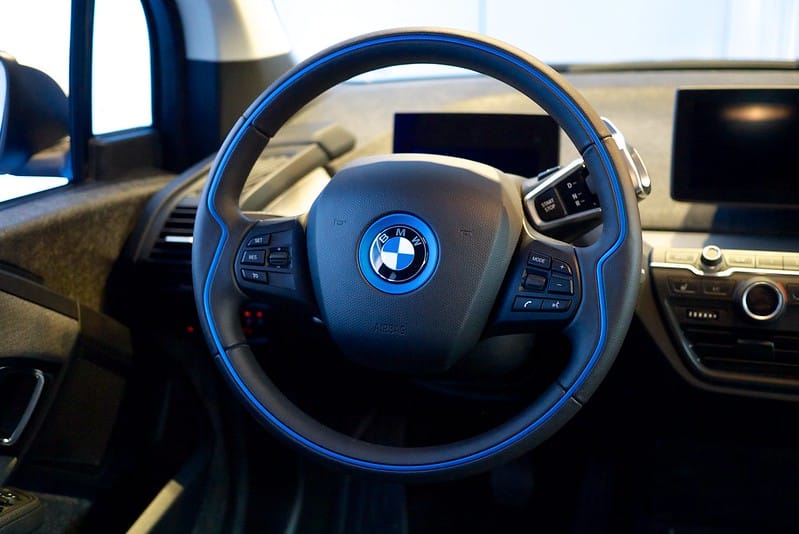
“BMW i3 electric car” by Janitors is licensed under CC BY 2.0.
BMW i3 Driving Modes
The BMW i3 has three driving modes – Comfort, Eco Pro, and Eco Pro+. These modes generally use a host of parameters to strike different balances between energy efficiency and performance. For example, the standard Comfort mode provides a range of 80 to 100 miles under daily driving conditions using only the battery. The REx option adds another 160 to 180 miles of range with a gasoline engine.
Eco Pro mode uses less power by changing the accelerator pedal mapping, which increases the i3’s range by about 12 percent. Eco Pro+ mode changes all available settings to maximize its range, resulting in a 24 percent increase over Comfort mode. For example, it limits the vehicle’s speed to 56 mph and switches electrical devices like air conditioning and heating to energy-saving mode.
The i3s adds the SPORT driving mode, which shifts the vehicle’s driving behavior towards performance. The most noticeable changes with this mode include a more aggressive response to the accelerator and slightly heavier steering.
Sources
http://transportevolved.com/2014/04/23/u-s-spec-bmw-i3-rex-smaller-gas-tank-range-hold-limited-speed/
http://www.bmw.com/com/en/newvehicles/i/i3/2013/showroom/technical_data.html#m=i3
https://bmwi3owner.com/2018/11/bmw-i3-2019-120ah/
https://insideevs.com/news/563722/bmw-i3-production-ends-202
More on EV Universe:
- Explore More EVs: Check out our comprehensive listings page for detailed information on top electric vehicles.
- Shop EV Parts: We’re more than just a source of information. Browse our extensive marketplace for a variety of EV parts and products.
- Insights & Updates: Stay updated in the world of electric vehicles with our insights section. Dive into our in-depth reviews, educational pieces, and the latest news.
- Find Your Perfect EV: Harness our EV Matchmaker tool to explore a diverse range of electric vehicles, filter by your preferences, and discover hidden gems that perfectly match your driving style and budget.

